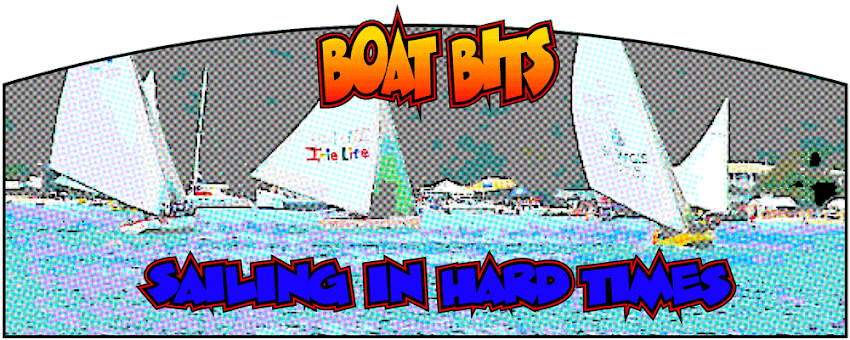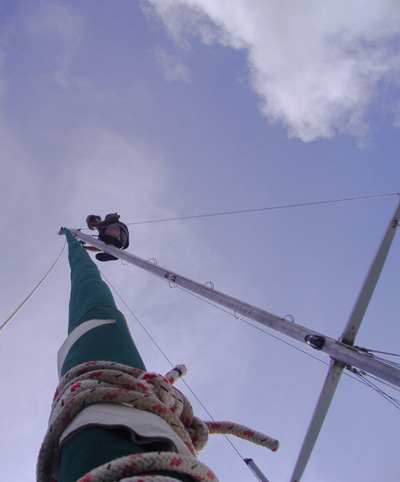A long time ago, while we were building a Wharram Tiki on a tiny island on the Seine, I was reading an American sailing magazine and took notice of a small mention and a drawing of a neat little scow... The fact is, I was so impressed with the idea of the scow that I remember cutting the little blurb out of the magazine and sticking it into my neat boat stuff file. The design in question was the "Harry" and the designer was a guy in British Columbia by the name of Tad Roberts...
Now, a whole bunch of years later, Tad is still designing neat boats and I'm still finding his designs interesting and very buildable. When I first started Boat Bits one of the ideas was I'd be able to talk to folks like Tad and ask various designer questions that I wanted answers to... Life, as they say, is good!
Hi Tad, what made you decide to become a NA?
These days I call myself a Boat Designer, Naval Architecture is part of what I do but I do other things as well: Art, Styling, Engineering, Social Commentary, Teaching, Lecturing and writing.What would you say are your major influences design-wise.
There really wasn't much choice, I knew what I was going to do at an early age, it just took a long time to figure out how to do it. Both my grandfathers and my father designed and built boats for themselves, and most of my relatives are involved with boats so it started early. I was drawing boats as soon as I could hold a pencil and just carried on, getting more sophisticated as I got older. Somehow I knew that seatime was required and so I spent many years crewing on anything I could get aboard, mostly commercial boats but also some sailing vessels.
This experience using, building, and maintaining boats showed to me that there was huge opportunity for improved designs. And that's the real reason for doing this, to create better boats. Boats can be prettier, easier to build, better performing, and simpler to use and maintain if those are set out as design goals.
My parents were early major influences. My mother is an artist and taught me about color, form, and balance, while my father is a pragmatist and was always talking about ways to make something better performing or easier to use or build. He also took me to sea for extended periods from a young age. This combination was particularly lucky for me.
Specific designers who have been influential include (in no particular order) L.F. Herreshoff, for design integrity. Maurice Griffiths, for good boats for average folks. Phil Bolger, for honesty in design, William Garden, for art, romance, and regional character. Billy and John Atkin, more good boats for average folks. Robert Harris, for personally encouraging me, and setting a seamanlike example in all types of designs. Dick Newick, simple and effective beautiful boats. Jay Benford, more buildable boats of strong character.
Of course, having worked with Bruce King for 14 years he had considerable influence, mainly in the areas of aesthetics and engineering.Your first design which caught my attention, "Harry", was both a scow and a minimal envelope cruiser which seems odd as most young designers are so busy doing their version of the same old same... What was your thought process about "Harry"?
Pretty tough to recall what I was thinking 26 years ago!
Harry (the person) is my grandfather Harry Roberts. He designed and built a number of boats (sailing and power) in the 1920's through the 60's here in BC. In his late 80's he was still working on the design of an "Old Man's Boat" as he called it. Harry was born in the south of England and came to BC in 1900 at the age of 16. I have always been interested in Thames Sailing Barges and I thought a small, simple to build, version of that would make an interesting old man's boat. I sold a few plans for Harry's and did some modified versions, but I have no idea if any were ever launched.
You also seem to think there is some market for small sailing cargo
carriers in the foreseeable future... How do you see your cargo schooner
designs coming into play?
In the early 1980's I belonged to an organization called SAILA (Sail Assist International Liaison Associates) intended to promote the use of auxiliary sailing vessels for all kinds of commercial work. I had experience fishing and carrying freight under sail and I still believe auxiliary sailing vessels make sense in many situations. In places like Kiribati where there is a tiny population spread over thousands of square miles of ocean, where air freight has just become too expensive and there are no harbours for even coaster sized container ships. These are the opportunities for simply built and inexpensively operated sailing vessels. The rig of these vessels must be simple, rugged, and versatile, high-tech masthead sloops will not work and are not possible given the minimal budget. Hard-chine vee bottom welded steel hulls fit the available skills and budgets.
Currently we're seeing many small communities going to landing barge type freight movers. The next step is sailing landing barges (or scow schooners) handling mini containers. Water is the least expensive (greenest) method of transportation of freight, currently much infrastructure is against small freight on the water but that might change. Harbours are expensive to build and maintain, therefore boats able to land or load freight anywhere should be able to compete if given a chance.
As a home builder of boats myself, I find that a real issue I have with a lot of designers is that they are so concentrated on the existing retail market and current fashion that they often ignore the actual reasons someone chooses to build a boat rather than buy.
Such as filling a niche that is not available to buy like shoal draft or a real cruising
boat instead of something that fits into the bareboat/floating condo mode... Care to jump into the fray?
I have no interest in doing a warmed up version of what’s already been done. One of the big gulfs is that production weekenders bear no relation to boats that people could build for themselves and live aboard while cruising. Yet the design business is focused on and judged by success in that production racer/cruiser market. IE you must be a “good” designer because Beneteau built 1,000 hulls to your design.
And these production boats are not user friendly, all systems are cheaply done, inaccessible, and un-repairable. The accommodation is designed around numerous berths and heads and no storage space. And the deck arrangements provide no shelter for the crew and uncomfortable undersized cockpits. One of my bigger beefs is the lack of any consideration of reasonable dinghy storage. And the rigs are ridiculously complex for the way they are used.
Today’s stock racer/cruiser is virtually identical to what was being offered 30 years ago except today’s boat is higher and wider with a smaller keel and different shaped windows. Okay, I’m exaggerating a bit… But the only market area attracting interest (sales) is where there’s innovation, for instance in multihulls. I think builders have missed innovation in cruising boats, rigs should be simpler and work better, draft should be shallower with moveable appendages, interiors should be friendlier and more useful, and decks should be safer.
Three words... Balanced Lug Rig...
I like lug rigs, one of my own boats (Ratty) is an unstayed partially-balanced standing lug cat ketch. This rig is totally forgiving and can be set up or taken out of the boat in a few minutes. I’ve drawn a number of balanced Chinese (fully battened) lug rigs and I’ve sailed a 54’ Colvin pinky with big balanced lug sails. The lack of sheet load was a huge revelation to me, also the lack of flapping and the instant power/depower.
What designs that you are currently working on have you excited?
So many boats and so little time! Currently the majority of my work is on powerboats and motorsailers, but pure sailing vessels remain a big interest. The “Future Cruiser” series have been percolating on a back burner for over a year. Without a client conceptual designs end up as a crusade for recognition and today I just have less time and energy for such undertakings. While that’s great for the stew pot, a designer has to push the new ideas out in the world.
Another new design underway is a simple vee-bottom aluminum ketch rigged motorsailer. The motorsailer has disappeared of late because virtually every sailing yacht is more than adequately powered. This boat will be of PNW character with much of the accommodation in a large pilothouse.
What do you feel your most successful sailboat design has been so far?
What’s “successful”? If you mean mission wise I could say Tern, having fulfilled her intended mission over a number of years. She was successfully built by a group of neophytes who then safely sailed (and rowed) her to Alaska and back. She continues to fill a role as a training vessel around Lopez Island, something which gives me great satisfaction.
Or, monetarily “successful”? That would be the Hinckley Sou’wester 70, Five of these have been built bringing considerable money and work to the Hinckley yard.
What's the design you've done that folks simply don't get or misunderstand?
That would be Ratty, my answer to what I thought was a need for a improved Drascombe boat that people could self-build.
If you were not designing boats what do you think you'd be doing?
I design and theorize about other things, houses, transportation systems, etc. I’m getting better at and enjoying writing more as I get older. When I can’t see to draw any more I’ll paint full time, mostly abstract landscape.
You were saying something the other day about a good method of home building as a
co-operative model, and as someone who has built two boats in a co-op situation, I personally can't understand why it has not caught on in North America as everyone we met building boats in Europe were in a co-op of one sort or another... Care to expand?
I first came across the idea 30 years ago and I have no idea why there aren’t more well known cooperatives. I guess it’s part of the independent nature of do-it-your-selfers that they would ignore that kind of group undertaking. We’ve (in North America) been taught independence, had it forced on us really from a young age. There’s something wrong with you if you can’t go it alone. But the internet (among other things) is changing that and people are finding others doing similar projects all across the globe, which is very cool.
But I’ve also noticed a shift in the typical home builder. 20-30 years ago it was not unusual to find a lone guy building a 48’ ketch or a 42’ trimaran in his backyard and intending to sail off to the southseas. Today home builders are working on 20-25’ fishing boats to go out on the weekend with their kids. I agree it’s perhaps a more realistic concept, but I miss the run-away-from-it-all dreamers.
Listening to Great Big Sea
So it goes...

















